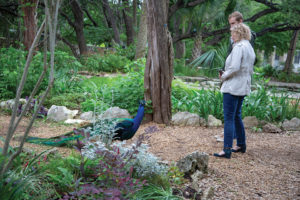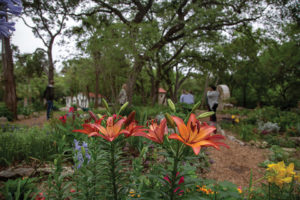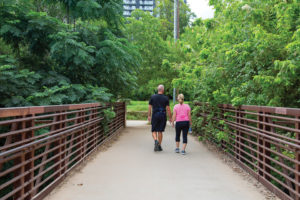Take a Hike

Lost keys, stuck in traffic, late for work, forgot passwords, 40 new emails to respond to, etc. With constant bombardment of technology, deadlines and expectations, life admittedly gets a bit overwhelming. Once more intense stressors pop up in life, the box of screens it creates can seem suffocating. But just a few moments outside, recent studies have shown, might just be the self-care necessary to make it through the rest of the week.
“We’ve lost something in the modern age,” Kathy Boyd says. She’s a licensed clinical social worker and has her own personal experience in watching the effects of technology take over the mental wellness of individuals. “People just don’t get out and move as much anymore.”
When was the last time you went outside, just because? Not to take the trash out or walk to your car on the other side of the lot.
In Austin, people seem to be drawn more to outdoor activities, making the response to that question a little more one-sided. But still, trends in a lack of perceived time to get outdoors limits the amount of time that people spend outdoors. In the ever-growing sphere and hectic buzz of urban life, it can seem impossible to keep a balance of concrete and cubicle to green space and fresh air. Jumping from home to car to bus to the office and back again, it can seem like running around racing an invisible clock leaves no time for self-care.

“It’s become the age of having the best car, the newest screen, latest trend,” Boyd says. “But then we forget to prioritize our own sanity.”
Ferny Barceló, a licensed professional counselor with her own private practice in Austin, Mind Body Peace, says she now makes “outdoor time” a part of every client’s coping methods.
“Much of the decline in mental wellbeing is due to the fact that we live such unnatural lives nowadays — disconnected from the rhythm of the earth,” Barceló explains. “We need to reconnect with our roots, literally, by going back to a more natural state of life that includes nature in our daily lives.”
But with a natural solution like the outdoors, cities everywhere are taking extra precautions to maximize and protect the natural assets that make the quality of life a bit better than in urbanized areas. Becoming a part of the biophilic city network, Austin is one of the top cities for life in nature and continues to develop more programs to increase the fresh air feel. The biophilic project aims to create cities that are deeply connected and integrated with the wildlife and natural habitats around them, and that’s exactly what Austin is aiming to do.
“The goal is that the city is not just with nature,” Timothy Beatley, the founder of the biophilic network and professor at the University of Virginia says. “But that the residents interact with that nature by caring about and for it.”
This need for access and opportunities outside is what makes Austin Parks and Recreation Department now have an even more important job than ever: keeping everyone sane and happy.

“Getting people involved in the outdoors is something very near and dear to me,” says Amanda Ross, the division manager for the Austin Parks and Recreation Nature-Based Programs. “Preservation and awareness are key.”
Many steps they’ve taken to bring the outdoors to the public are focused on educational and enacting programs. These, like the Nature & Science Center, allow people and youth to learn about the various natural assets in Austin and how to use them.
“People have to be comfortable with the outdoors before they can appreciate it,” Ross explains.
“A lot of that comes from just understanding what things are and why they’re important to the environment.”
The Nature & Science Center focuses on younger generations, helping them to connect with the outdoors from an early age. Petting bunnies, identifying rocks, playing in the creek — all of it is for them to still feel like a part of the environment even in the urban setting.
“Getting kids outdoors is absolutely necessary,” Boyd says. She works with children in Tarrytown, specializing in dyslexia, and notes the importance of those moments outside. “There’s a lot of stress that even kids go through, and the outdoors allows them to reset their bodies and their little, emotional hearts.”
Being outdoors has shown to improve focus, creativity and reduce stress, blood pressure and inflammation. So, the benefits of going on a 15-minute walk or hike aren’t just set aside for kids at recess.
“Escaping the chaos of daily life is important for every age,” Ross says. “Then, there’s a space to quiet the mind and turn off all the stressors, even just for a little while.”
The department has plenty of ways for every age to get involved, whether it’s volunteering or just participating in one of the workshops or community outreach events — there’s something for everyone to get started and get happy.
Community gardens are a popular way in Austin, as the communal aspect of interacting with others combined with eating your own grown food boosts appreciation for the way the Earth works.
“You’ve just gotta get out, get moving, get breathing and get interacting,” Boyd says. “That’s how you start to work against depression.”

Stopping at one of the access points for the Green Belt, taking a dip in Barton Springs, laying out on the grass at Zilker or one of the many other parks the city has to offer — it’s clear it’s all crucial to excel in all other aspects of daily life.
“We are mammals who aren’t meant to sit all day in front of a screen and closed-off,” Barceló says, “We were meant to rise with the sun, sleep when it’s dark and to commune with nature on a daily basis.”
After work, rather than sitting in traffic for another hour or so, try changing at work and opting for a walk while waiting for traffic to pass. Nothing major, no strenuous hike, no sweaty marathon, just a walk with some trees and some fresh air. No bosses, no emails, no thoughts of the commute home — unplugged and in nature.
Leave No Trace:
In order to keep these environments around to benefit mental wellness, be sure to practice the seven principles of Leave No Trace:
1. Plan ahead and prepare
2. Travel and camp on durable surfaces
3. Dispose of waste properly
4. Leave what you find
5. Minimize campfire impact
6. Respect wildlife
7. Be considerate of other visitors
For details on each step visit:
int.org






